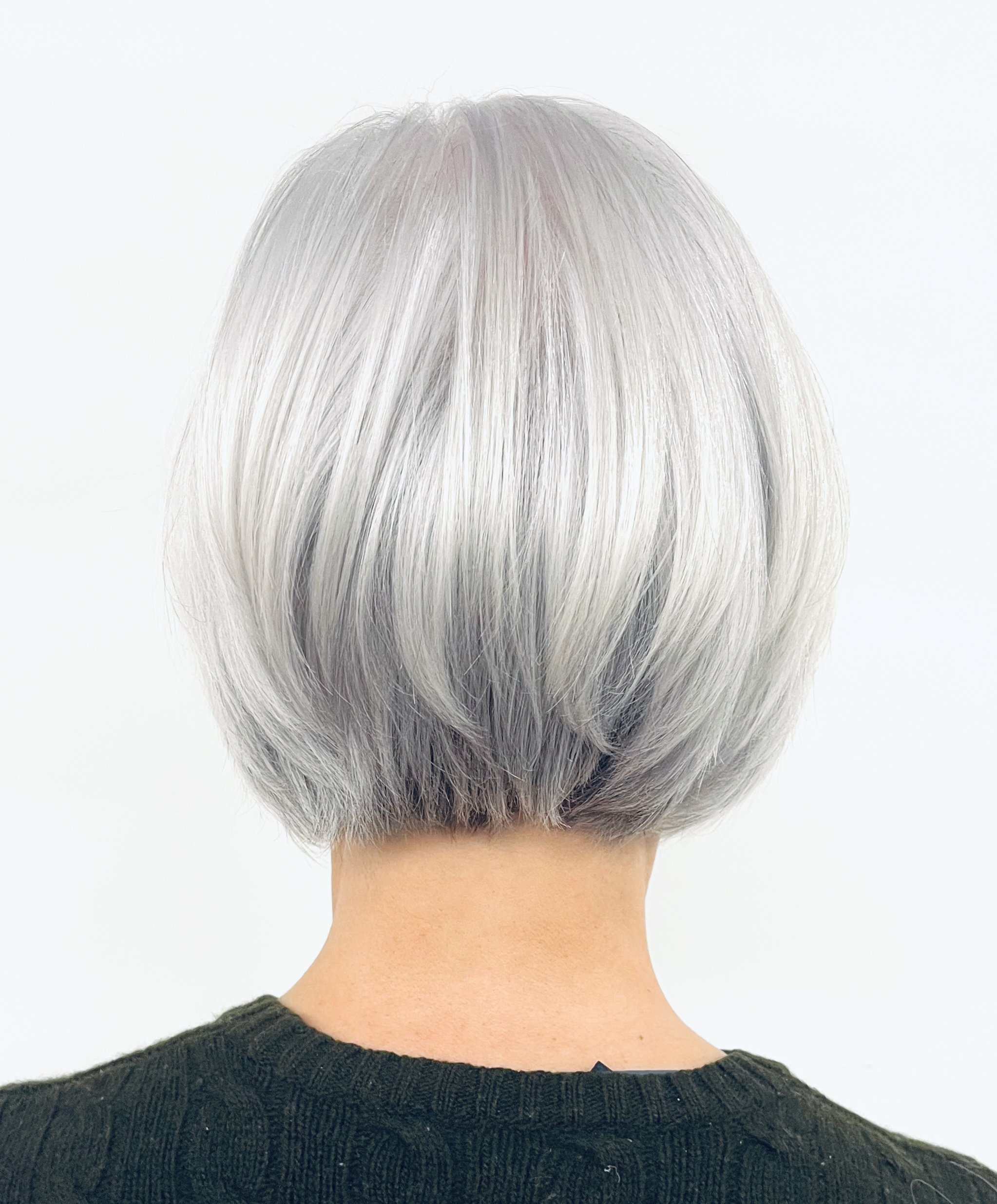Gray-Blending for Natural & Dimensional Color
Embrace your hair with gray-blending!
Now, more than ever, you've got options for covering gray.
We all age, let’s celebrate our years! Gray, silver, and platinum hair is all the buzz, with more and more women ditching high-maintenance, monochromatic tones for more lived-in looks.
Gray blending techniques incorporate foil highlights and lowlights that vary in weight and placement to provide a highly customized color unique to you.
There's gray hair blending for blonde hair and dark hair, as well as auburn and red hair. This multi-faceted technique uses different shades of hair color to create a gradual transition that incorporates your gray hair with your natural color (or chosen base color.)
With this technique, gray hairs aren't covered; they're enveloped within the pattern of color, resulting in a softer, more natural look that needs less maintenance than one-process color. You can choose to maintain your look or use this process to slowly transition towards all gray.
Once you start the transition process, you can expect your maintenance and upkeep to be about 8 to 12 weeks apart, depending on your chosen method. Typically, it takes about 3 to 4 salon visits to complete the process and get your hair to the desired state.
Gray Blending vs. Basic Gray Coverage
Gray Blending
A term used for various techniques that can help to incorporate and disguise gray hair. Unlike one-process color, this technique gives a more natural-looking result without a hard line of regrowth. It can also extend the time needed between services.
Gray blending techniques incorporate foil highlights and lowlights that vary in weight and placement to provide a highly customized color unique to you.
There's blending for light and dark hair, as well as auburn and red hair.
Uses multiple shades of hair color to create a gradual transition that incorporates your gray hair with your natural color (or chosen base color.) With this multi-tonal technique, gray hairs aren't covered; they're enveloped within the pattern of color, resulting in a softer, more natural look that needs less maintenance than one-process color.
You can choose to maintain your look or use this process to slowly transition towards all gray.
Basic Gray Coverage
Here's an analogy of the three levels of basic gray coverage. For decades, these three techniques were the standards for covering your gray, with most women opting for full coverage.
Full coverage covers 100% of the gray with a one-process color. Think of this as wearing colored, opaque tights.
Demi-permanent coverage covers about 80% of your grays using less pigmented dye. This method lets some of your own tone and grays show through. This like wearing see through, colored pantyhose.
No coverage, letting your natural gray and silver hair color come through completely. We always suggest adding a gloss to add shine, balance and eliminate yellow and brassy tones. Think of this like wearing sheer, nude pantyhose.
“What if I have been dying my hair for years?”
For clients who have been coloring their hair darker for years and want to go natural, there are now more options than ever with for covering gray.
1
Your stylist can use your previous hair color as a guide to highlight or lowlight the hair around your face. Lowlights are applied using the same technique as highlights, but darker tones are used to create depth and dimension. This technique helps to avoid a harsh line of color contrast, which can be unflattering as your hair grows out. It also allows people with longer hair to pull it back in a ponytail, making the gray hair in the back less noticeable.
2
Your stylist can help you manage your gray hair by selecting specific areas where it’s growing out, such as around your face and through your part where you section your hair. They can then apply highlights to these areas that are close in color to your silver hair. To complete the look, your stylist should apply a toner to unify the color, eliminate brassiness, and add shine.
3
If you want to stop dyeing your hair, you have the option of growing out your natural hair. On average, your hair grows about ½" to ¾" per month. So, if you want to grow your hair to shoulder-length bob, it would take approximately a year and a half without any intervention. One way to transition to your natural hair color is to cut your hair short to remove most of the dyed hair. Then, let it grow out while getting regular trims to remove the remaining colored portions. Once the dyed hair is gone, your natural hair color can grow as long as you desire.
4
Dyeing your entire head silver in one session is an option, but one you should consider with caution. Many people are curious about how long the process of grey blending takes because they have seen amazing transformations on social media. While it’s technically possible for some people's hair to lift enough artificial color in one session, this level of alteration is quite rare. Despite online videos that seem to show quick and easy solutions, the truth is that these types of color appointments are expensive and can take 10 to 12 hours in your stylist's chair, with no guarantee of the desired results.
5
We suggest using a toner or tinted gloss for all gray blending hair color methods and clients with existing gray hair. Natural gray hair can have yellow, brassy, or mousy-brown tones that a toner can brighten and balance, leaving a mirror-like shine.
6
The timeline for hair regrowth varies from person to person and depends on various factors such as the health and length of your hair, the coloring technique you choose, and how quickly you want to achieve your desired look. If you are looking to cover your gray hair, your stylist will likely need about three to four months of regrowth to see your gray pattern. Although this time is not mandatory, it allows your stylist to create a more effective color plan for you.

Gray hair, don’t care!
Book an appointment with us today!

Close-up of a woman with short, layered gray hair with blonde highlights, smiling and wearing a gray top.

Comparison of a woman's curly hair before and after styling: on the left, voluminous, defined silver curls; on the right, frizzier, unstyled natural curls.

Side-by-side portrait of a woman with long brown hair, wearing a gray sweatshirt with pink and red stripes on the sleeves, showing a before-and-after hairstyle change; the left side displays her with slightly longer, straight hair, and the right side shows her with shorter, voluminous, styled hair and a smiling expression.

Side-by-side comparison of a woman's hair before and after a haircut and color treatment. The left image shows her hair before, with a blunt cut and darker roots, while the right image shows her after with a layered, shoulder-length style and lighter, honey-blonde color.

Side-by-side comparison of a woman's hair before and after a haircut and styling. The left image shows longer, unstyled hair with some gray, while the right image shows a shorter, styled haircut with layered, blonde hair.

Side-by-side comparison of a woman's curly hair before and after a professional styling. The left side shows her with frizzy, unstyled curls, and the right side displays her with defined, bouncy curls after styling.

Comparison of hair before and after a hair treatment; the before image shows dull, frizzy hair with uneven color, while the after image shows shiny, smooth, and evenly colored blonde hair.

Side-by-side comparison of a woman's hair before and after a professional hair coloring or styling session. The left shows her hair with multiple blonde shades and visible roots, while the right displays her hair with a smooth, evenly colored blonde tone and a sleek finish.

Comparison of a woman's hair before and after hair coloring, showing darker, less vibrant hair before and brighter, caramel-colored hair after.

Back of a person's head with short, layered, gray and white hair, wearing a black sweater.

Back of a woman with shoulder-length blonde hair with highlights, wearing a beige sweater, against a plain white wall.

Two women with shoulder-length wavy hair, the woman on the left has gray and blonde hair, smiling and looking to her right; the woman on the right has light brown hair, turned away from the camera, showing only the profile and back of her head.


